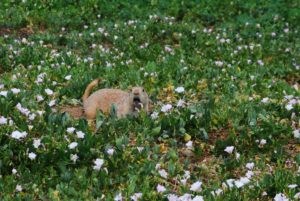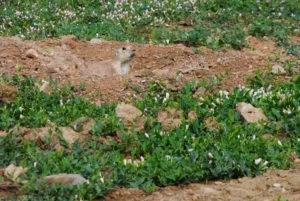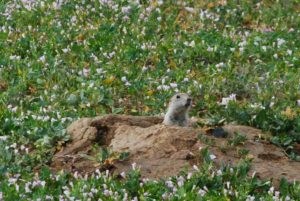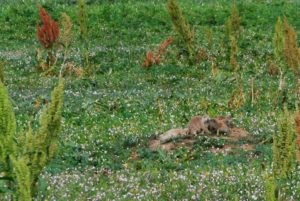This content was originally published by the Longmont Observer and is licensed under a Creative Commons license.
Love them or hate them, Longmont has pockets of prairie dogs. There is perhaps no other species in Boulder County that is as polarizing as the prairie dog. What exactly is it about this small critter that provokes such strong reactions?
Prairie dogs are actually a member of the squirrel family and five species occur in North America. The species of prairie dog in Longmont is the black-tailed prairie dog. They are tan in color with a white or buff-colored belly and a black tip on the tail. Because they are a burrowing species, they have small ears and well-developed claws. They are 14-17 inches long at maturity and weigh 1-3 pounds.
Prairie dogs are a highly social species. They live in family groups called coteries which consist of a male and several females and juveniles. Each coterie may have up to 12 individuals. Groups of coteries make up wards and groups of wards make up prairie dog towns or colonies. The largest town on record was in Texas and was 25,000 square miles with about 400 million prairie dogs. Prairie dogs live in short-grass prairie, preferring to avoid areas where they cannot visually see for long distances because they are unable to see predators coming if vegetation is too high.

Prairie dogs are considered a keystone species, having numerous positive impacts on the species they live with and the environment. For example, prairie dogs aerate the soil, their burrows provide housing for other species such as burrowing owls, and they serve as prey for snakes, hawks, foxes, and coyotes. Over 170 species benefit by the presence of prairie dogs.
Black-tailed prairie dogs build underground burrows that are connected by tunnels. Burrows typically have several entrances to allow for quick escape from predators. Prairie dogs may burrow up to 15 feet underground. The burrows serve several different purposes. Near the tunnel exit to the outside, there are so-called ‘listening chambers’ that allow prairie dogs to determine whether there are predators outside before they go above ground. Nesting chambers are lined with dry grass and are about 12 inches by 20 inches. They may be used to raise young or for general sleeping. Temperatures in the burrows during the winter range from 40 to 50 degrees Fahrenheit. During the summer, burrow temperatures range from 60 to 75 degrees Fahrenheit. Unlike some other prairie dog species, black-tailed prairie dogs do not hibernate.
Burrow entrances are one of three types. One type of entrance is just a hole in the ground with no conspicuous dirt around it. These are used to quickly escape from predators. Another type is called a dome crater.


Black-tailed prairie dogs have up to 12 different types of calls. It is thought that prairie dogs have the ability to communicate what general type of predator is present and the urgency of the danger. Antipredator calls are usually a “chirk” sound, but there are subtle variations that may indicate what type of predator is present. Specifically, they may have one type of alarm call for snakes and another for hawks. Calls may come at a faster rate when danger is closer than when it is farther away. Prairie dogs also reinforce communal bonds by giving a jump-yip. The animals look as though they are doing the wave as the bark spreads throughout the colony. During a jump-yip, the prairie dog raises itself up on hind legs and stretches upwards, arching its back, throwing its front feet in the air, giving a yipping sound. The jump-yip bark usually starts a chain reaction throughout the colony with nearby prairie dogs following suit and calling.

The next time you are near one of these colonies, take some time to watch from a distance. Binoculars or spotting scopes are a good way to observe prairie dogs. If you hear the prairie dogs making alarm calls and observe them running to their burrows, you are likely too close. Back off a bit and wait and you will be rewarded by seeing a variety of interactions between these fascinating animals.
The Longmont Weekly Wild is a weekly column about all things wildlife and wild in Longmont. You can find previous articles under the Lifestyle section.


